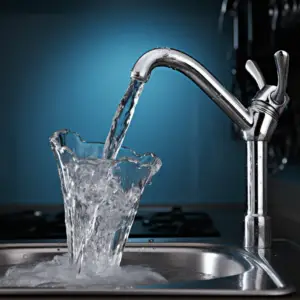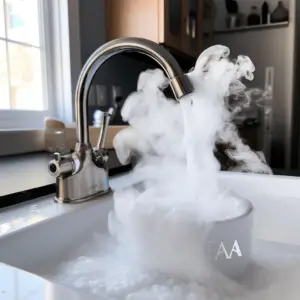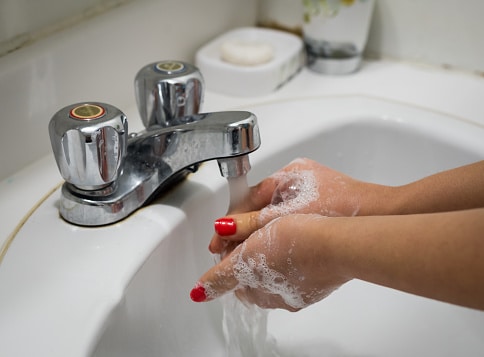Foamy Life need tap water. It has many daily uses. What’s its source, how does it enter your home, and where is it stored? Various concerns with tap water contribute to its unfavorable connotation, leading some to avoid it.
Table of Contents
Why is My Tap Water Foamy?

The dispensing spout injects air into the tap water, making it frothy but not sudsy. Pipe water has more pressure than glass water.
When water is pumped through pipes quickly, it mixes faster and forms bubbles with air. Air injected into water aerates it to the point where the bubbles are incredibly tiny and look like foam.
Foamy water is safe to drink and use. As shown in the next section, replacing or updating the faucet fixes the problem.
How to Fix Foamy Tap Water?
It is a great concern to see white foam in tap water. Many people often boil their drinking water and not the direct tap water.
Knowing the cause of foam in tap water is out of the pressure from the aerator or a faulty plumbing fixture that needs to be fixed. To achieve the solution, follow the below steps:
Close Off The Water Supply
Cut off the water supply to the tap to allow you to open up the faucet spout and examine its underneath and also to prevent water from splashing all over the house.
It is more important to turn off the water supply using a valve.
Next, let the remaining water drain out of the faucet by turning it on once more for a few minutes.
After which, you can now start working on fixing the foamy tap. Spend quite a good amount of time at this step to avoid water damage.
Remove the Faucet Spout
This procedure removes the faucet spout. Faucets vary, but many spin off easily.
Remove the faucet completely to see the aerator. To eliminate frothy tap water, the aerator will be properly cleaned. Check the faucet’s exterior for damage.
Brush the Aerator
The aerator resembles a little mesh ring covering the exit to the faucet spout.
It is common to see the white foam when the tap is on but what you didn’t know is the aerator is the reason for the foamy tap water.
Examine the aerator for any sediment and other forms of debris for you to understand the reason behind the problem.
The best way to remove the debris from an aerator is to use a brush, and in this case, a toothbrush does a wonderful job. Do it thoroughly to ensure everything is scrubbed off by re-installing the aerator.
Additionally, you can replace the faucet aerator with a new one, although it is not a must.
Tighten the Spout
It is the final step –tightening the faucet spout.
Install everything back, and after that, turn on the water to confirm whether it is functioning properly or not.
It is paramount to check whether there is still foam in the tap water.
If it is not working, then you need to replace the aerator. If you replaced it, the primary issue might be the water source. Under the circumstances, you need to consult with an expert.
What is Tap Water and Its Source?
Water supplied through a tap, a water dispenser valve is referred to as Tap Water (Faucet water, Running water, or Municipal water).
Tap water is regularly used for drinking, cooking, laundry and lavatory flushing. It is usually distributed within the house through “indoor plumbing”. Faucet water comes from three major sources-lakes, rivers and groundwater. But this depends on where you are located because of the variance in water sources. An alternative to Tap Water is spring water.
Pros and cons of Tap Water
Safety
The Environmental Protection Agency (EPA) is accountable for tap water quality. They identify and set limits for the number of contaminants present in the tap water and groundwater, which entails chemicals and microorganisms.
If there is any concern with tap water, the federal law dictates that the water companies must inform the public.
To improve safety in your tap, think about filtering your water with carbon filters or other through a reverse-osmosis system.
Taste
It has a natural taste rich in minerals.
Cost and convenience- Drinking tap water is affordable and timely. It is available in both home and public places.
Environmental impact
To elude contamination, water companies treat public drinking water with chemicals using an arranged process to channel it to the holding tanks.
How safe is the Foamy Tap Water?

As we’ve seen from the previous sections, the issue of foamy water is due to the plumbing fixture being loose or not properly installed, for example, a faulty aerator in the faucet. Such problems are fixed with ease, and they aren’t alarming. In concussion, we can say that foamy water from your tap is safe and can be used.
Health Benefits of Water
Hydrating yourself with water should be part of your daily regime because for many reasons, such as:
- Lubricate and soften joints
- Keep a normal temperature range
- Guard your spinal cord and other liable tissues
- Prevent Dehydration
- Get rid of waste through urination, sweat and bowel movements.
The tap water can become foamy when there is a loose or dirt faucet aerator. It is best to fix the issue by turning off the water supply, removing the faucet spout, and cleaning the aerator using a brush. Lastly, reinstall the parts and retest the tap water.


